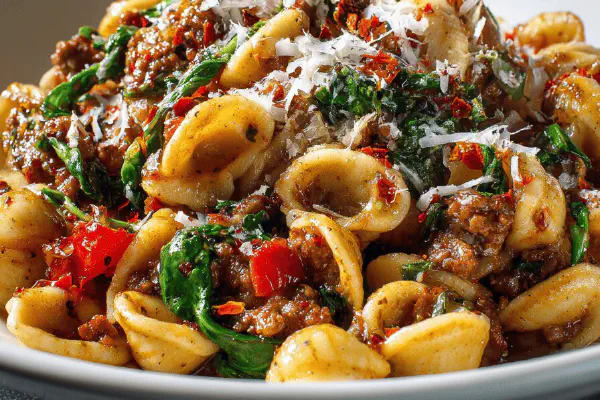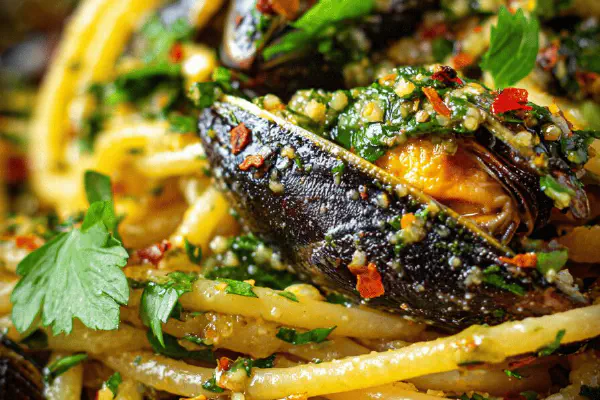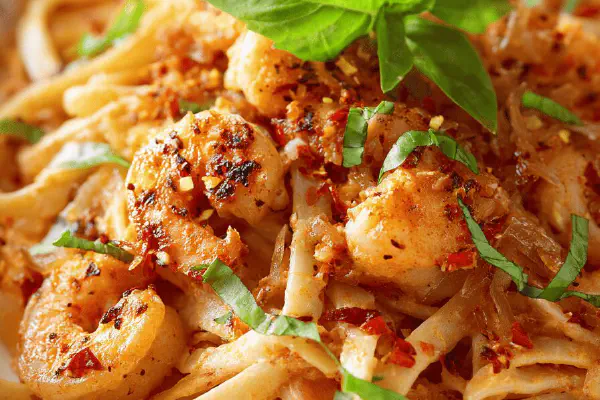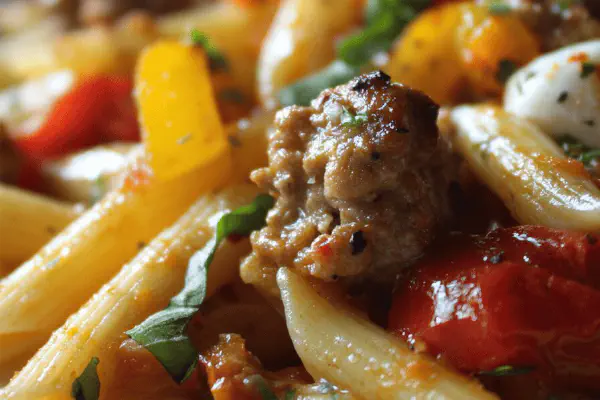Shrimp Spicy Penne Twist
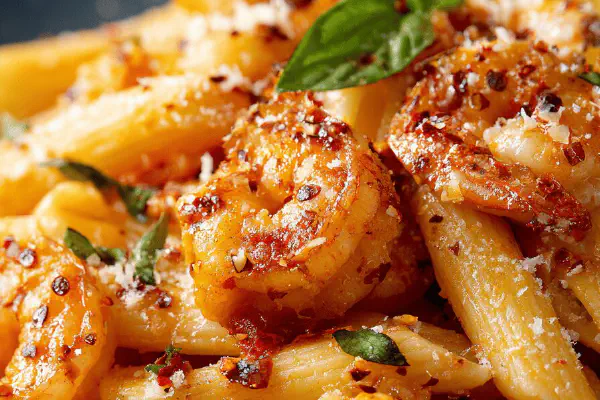
By Emma
Certified Culinary Professional
Ingredients
Spicy tomato sauce
- 1 medium yellow onion, finely chopped
- 4 ml (3/4 tsp) crushed red chili flakes, adjust to heat preference
- 50 ml (3 1/2 tbsp) extra virgin olive oil
- 3 cloves garlic, minced
- 70 ml (about 1/3 cup) dry white wine
- 1 can (800 ml or 28 oz) crushed Italian plum tomatoes
Pasta and shrimp
- 400 g (14 oz) penne rigate pasta
- 450 g (1 lb) large peeled raw shrimp, tails optional, patted dry
- 25 ml (1 1/2 tbsp) olive oil
- 1 tbsp lemon zest
- 1 tbsp fresh lemon juice
- 20 ml (1 1/2 tbsp) chopped fresh basil leaves
- 100 ml (about 1/2 cup) grated pecorino romano cheese
- Salt and freshly ground black pepper
About the ingredients
Method
Sauce assembly
- 1. Heat olive oil in medium saucepan over medium heat. Sweat chopped onion and crushed chili flakes till softened and fragrant, about 6 minutes. Season with salt and pepper.
- 2. Add garlic and cook until fragrant, about 1 minute. Pour in white wine, increase heat and reduce by roughly half, around 8 minutes.
- 3. Add crushed tomatoes, stir, reduce heat to low and simmer uncovered for 15 minutes. Taste and adjust salt, pepper, and chili flakes as desired. Stir occasionally.
Cooking pasta and shrimp
- 4. Bring large pot salted water to boil. Drop in penne and cook about 10 minutes until just al dente. Drain piping hot, toss with a drizzle of olive oil to prevent sticking. Set aside.
- 5. While pasta cooks, heat olive oil in large skillet over high flame. Add shrimp, season with salt and pepper, and sear quickly until pink and opaque, about 2-3 minutes per side depending on size.
- 6. Add lemon zest and lemon juice to shrimp. Give sauce a quick stir and pour it over shrimp, simmer briefly to combine and bring to gentle bubble, about 2 minutes.
- 7. Add drained pasta directly to the skillet with shrimp and sauce. Toss with fresh basil. Adjust seasoning if needed.
- 8. Serve immediately, sprinkled generously with grated pecorino romano.
Cooking tips
Chef's notes
- 💡 Start on onion low heat, sweat slow. Avoid browning or bitterness. Chili flakes early, bloom in oil, heat deepens but keep watch to not burn. Garlic in last minute, sharp punch, no raw taste. Wine steady simmer, reduce slow, takes time — keep bubble steady. Tomato simmer longer, 15 min for thicker, richer sauce. Stir off and on, no lid to evaporate.
- 💡 Pasta timing key — cook just shy al dente, about 10 minutes. Overcook and it mushes. Hot drain, toss with olive oil to stop sticking immediately. Set aside in warm. Shrimp sear hot and fast, don’t crowd pan or steam forms, loses crunch. Flip only once. Pink and opaque, no rancid smell, no extra liquid in pan. Lemon zest and juice added after sear, not before, to avoid bitterness, citrus oils fresh but not overpowering.
- 💡 Combining pasta with shrimp and sauce in pan, toss quickly but gently. Basil added at end, fresh leaves torn or chopped, avoid cooking down or flavor loss. Pecorino romano grated at service only, not melted in sauce — keeps salty punch intact with contrasting texture. Salt and pepper added at multiple steps; taste and adjust often to keep balance. Keep heat gentle when combining, long simmer burns basil and lemon brightness.
- 💡 Olive oil quantities matter — extra virgin to sweat onion and chili, regular olive oil for shrimp sear. Keeps flavors distinct. Dry shrimp important: pat dry thoroughly to avoid water splatter and better sear. Tails optional but remove if preferred for easier eating. Use canned crushed tomatoes for consistency and acidity; avoid fresh tomatoes for this flavor profile. White wine can be dry or medium dry, not sweet, to balance acidity and deepen sauce.
- 💡 Simmer sauce uncovered with stirring helps thicken. Avoid high heat here or sauce tastes raw and thin. Pasta stirred and tossed right after drain. Shrimp timing crucial; overcook and texture toughens. Lemon juice splash at end cuts richness, wakes sauce, bright without sourness. Basil last minute keeps green, fresh. Pecorino romano sharper than Parmigiano; expect salty, assertive finish. Adjust chili flakes to taste but lower ratio balances heat with brightness.
Common questions
How to keep shrimp tender?
Sear hot and fast. Don’t overcrowd pan or steam. Flip once, pink opaque means done. Overcook and shrimp tough, rubbery texture. Dry shrimp before cooking helps, removes moisture that causes boiling instead of searing.
Can I use fresh tomatoes?
Possible but changes texture, acidity. Canned crushed tomatoes preferred for thickness, consistent flavor. Fresh needs longer cooking, breaking down frustrating. If using fresh, remove skins, seed extra water, cook slowly to thicken sauce.
Pasta too sticky?
Drain hot pasta promptly. Toss with some olive oil right away. Don’t rinse—loses starch which helps sauce cling. Stir often while simmering in sauce so pasta doesn’t clump. Cook pasta less than package time to keep firm and prevent mush.
How to store leftovers?
Store pasta and sauce separate if possible. Refrigerate in airtight container up to 2 days. Shrimp tougher reheated; gentle warming on low with splash water or wine works. Can freeze sauce without shrimp. Thaw slowly and combine fresh shrimp later for best texture.
